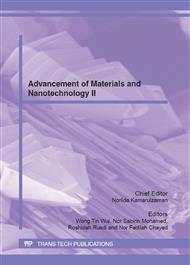[1]
C.S. Dandeneau, Y.H. Jeon, C.T. Shelton, T.K. Plant, D.P. Cann and B.J. Gibbons, J. Thin Solid Film., 517, 4448 (2008).
DOI: 10.1016/j.tsf.2009.01.054
Google Scholar
[2]
M. Vafaee and M.S. Ghamsari, J. Materials Lett., 61, 3265 (2007).
Google Scholar
[3]
Wiley, in: Synthesis, Properties, and Applications of Oxide Nanomaterials, Vol. 1, p.1, J. A. Rodriguez and M. Fernandez-Garcia, Ed. (John Wiley & sons, Canada, 2007).
Google Scholar
[4]
Z. Hu, G. Oskam, R.L. Penn, N. Pesika and P.C. Searson., J. Phys. Chem. B., 107 (2003).
Google Scholar
[5]
G. Oskam, J. Sol–Gel Sci. Technol., 37, 161 (2006).
Google Scholar
[6]
R.V. Kumar, Y. Mastai and A. Gedaken., J. Chem Mater., 12, 3892 (2000).
Google Scholar
[7]
A.Y. Baranchikov, V.K. Ivanov and Y.D. Tretyakov., Russian Chem. Rev., 76, 133 (2007).
Google Scholar
[8]
K.S. Suslick, S.B. Choe, A.A. Cichowlas and M.W. Grinstaff., Nature., 353, 414 (1991).
Google Scholar
[9]
T. Hyeon, M. Fang and K.S. Suslick., J. Am. Chem. Soc., 118, 5492 (1996).
Google Scholar
[10]
X. Cao, Y. Koltypin, G. Katabi, I. Felner and A. Gedanken., J. Mater. Res., 12, 402 (1997).
Google Scholar
[11]
W. Shlomit, R. Prozorov, Y. Cohen, D. Aurbach, S. Margel and A. Gedanken., J. Mater. Res., 13, 211 (1998).
Google Scholar
[12]
R.V. Kumar, Y. Diamant and A. Gedanken., J. Chem Mater., 12, 2301 (2000).
Google Scholar
[13]
Wiley, Zinc Oxide: Fundamental, Materials and Device Technology, Vol. 1, p.59, H. Morkoc and U. Ozgur, Ed. (Wiley-VCH Publications, Weinheim Germany 2009).
Google Scholar
[14]
K. Sanfra, C.K. Sarkar and M.K. Mukherjee., Thin Solid Films., 213, 226 (1992).
Google Scholar
[15]
G. Li, N.M. Dimitrijevic, L. Chen, T. Rajh and K.A. Gray., J. Phys. Chem. C., 112, 19040 (2008).
Google Scholar
[16]
U. Pal and P. Santiago., J. Phys. Chem. B., 109, 15317 (2005).
Google Scholar
[17]
S.I. Nikitenko, Y. Koltypin, Y. Mastai, M. Koltypin and A. Gedanken., J. Mater. Chem., 12, 1450 (2002).
Google Scholar
[18]
T.P. Chou, Q. Zhang, G.E. Fryxell and G. Cao., Cells Adv. Mater. 19, 2588 (2007).
Google Scholar
[19]
A.A. Khassin, V. V. Pelipenko, T.P. Minyukova, V.I. Zaikovskii, D.I. Kochubey and T.M. Yurieva., Catal. Today., 112, 143 (2006).
DOI: 10.1016/j.cattod.2005.11.047
Google Scholar
[20]
H. Okamura, J. Naitoh, T. Nanba, M. Matoba, M. Nishioka, S. Anzai, I. Shimoyama, K. Fukui, H. Miura, H. Nakagawa, K. Nakagawa and T. Kinoshita., Solid State Commun., 112, 91 (1999).
DOI: 10.1016/s0038-1098(99)00277-x
Google Scholar
[21]
M.N. Kamalasanan and S. Chandra., Thin Solid Films., 288, 112 (1996).
Google Scholar
[22]
C.H. Hung and W.T. Whang, Mater. Chem. Phys., 82, 705 (2003).
Google Scholar


